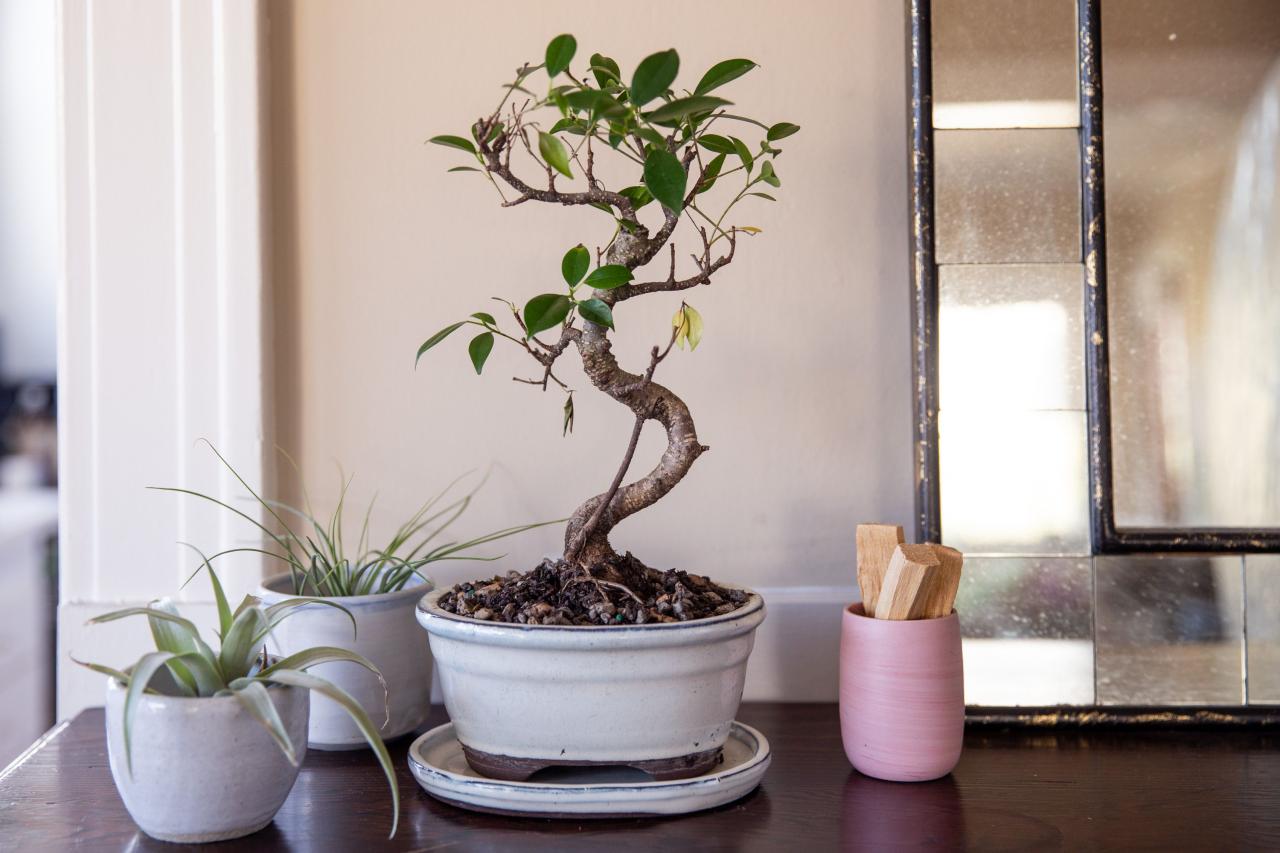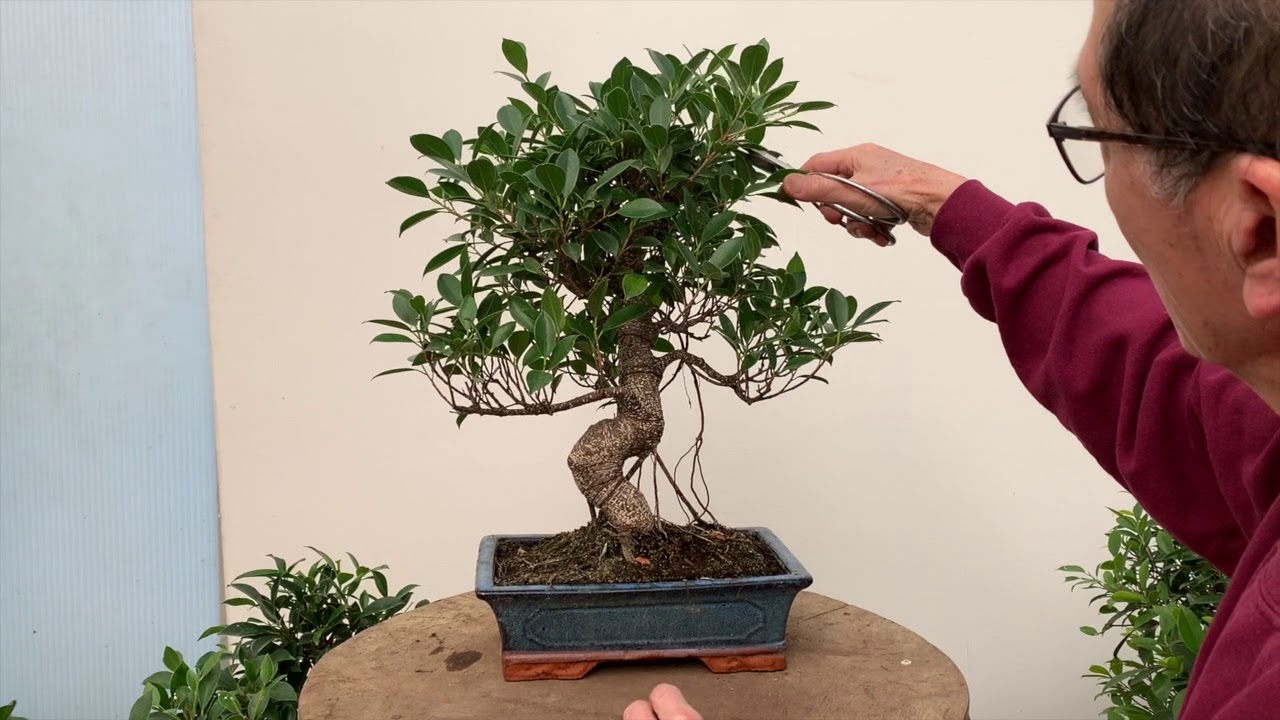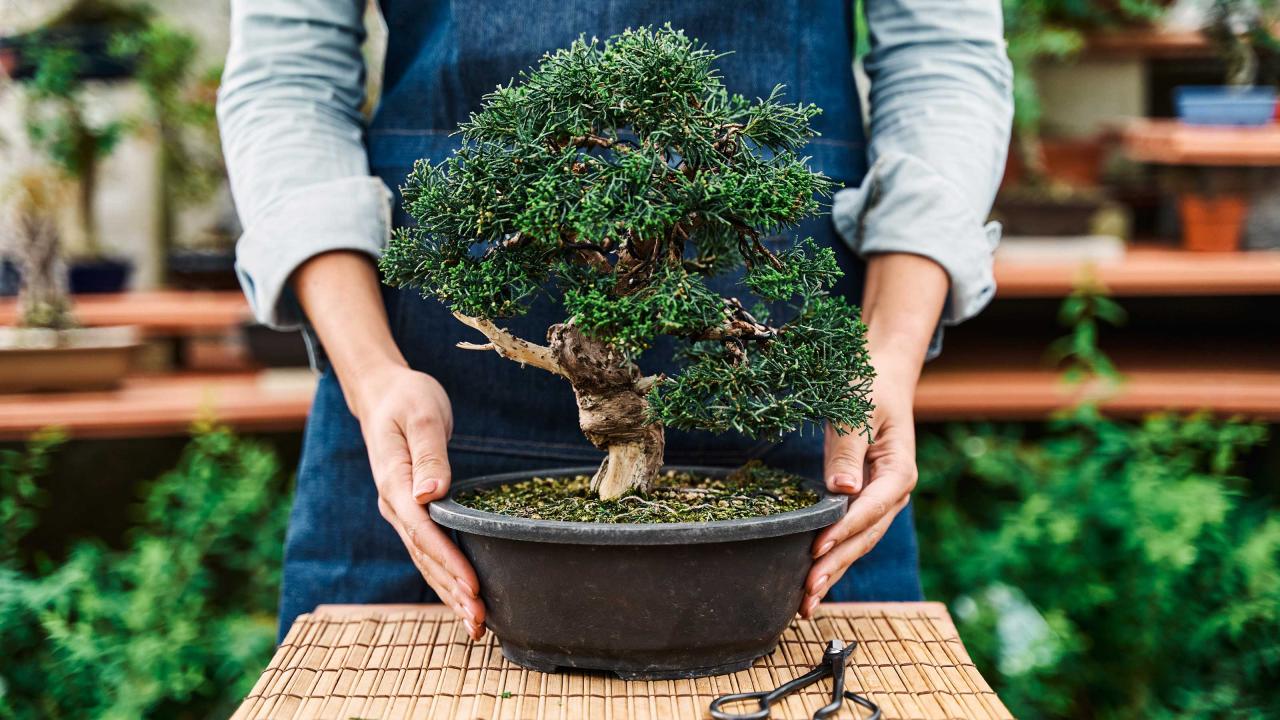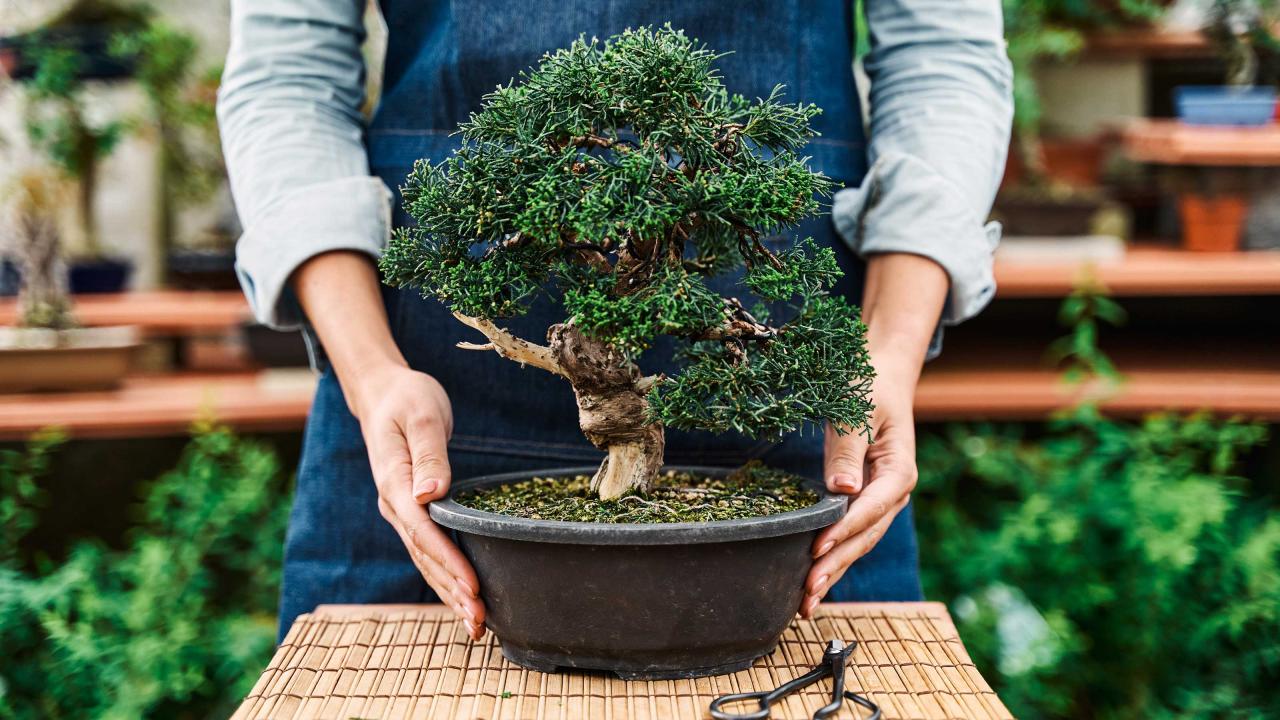How To Care For A Bonsai Tree Year-Round: Embark on a journey into the captivating world of bonsai, where miniature trees capture the essence of nature’s grandeur. These living works of art demand meticulous care and attention, requiring a deep understanding of their unique needs throughout the year.
From the delicate art of pruning to the crucial task of repotting, each season presents a new set of challenges and rewards for the dedicated bonsai enthusiast. This comprehensive guide will equip you with the knowledge and skills necessary to nurture your bonsai tree, ensuring its vibrant health and longevity.
Bonsai, meaning “planted in a tray,” are miniature trees cultivated in pots, meticulously shaped and pruned to mimic the growth patterns of their full-sized counterparts. These living sculptures, often revered for their artistic beauty and cultural significance, demand a deep understanding of their specific needs.
The art of bonsai care extends beyond basic horticultural practices, encompassing a delicate balance of pruning, shaping, watering, fertilizing, and repotting, all tailored to the unique characteristics of each species.
Essential Bonsai Care Practices

Providing the right care for your bonsai tree is essential for its long-term health and beauty. Understanding the fundamental practices of watering, drainage, and fertilization will ensure your bonsai thrives.
Watering Bonsai Trees
Proper watering is crucial for maintaining the health of your bonsai tree. It’s important to strike a balance, avoiding both overwatering and underwatering. Overwatering can lead to root rot, while underwatering can cause the tree to become stressed and even die.
- Frequency:The frequency of watering depends on factors such as the type of bonsai, the size of the pot, the soil type, and the climate. Generally, you should water your bonsai when the top inch of soil feels dry to the touch.
However, it’s best to observe your specific tree and adjust watering based on its needs.
- Water Quality:Use rainwater or tap water that has been allowed to sit out for 24 hours to remove chlorine and other chemicals. Avoid using distilled water as it lacks essential minerals that bonsai trees need.
- Watering Technique:When watering, thoroughly soak the soil until water drains out of the drainage holes. Allow the excess water to drain completely before placing the bonsai back in its original location.
Soil Drainage
Good soil drainage is essential for preventing root rot. Bonsai soil should be well-draining, allowing excess water to pass through quickly.
- Soil Composition:Bonsai soil is typically a mixture of different components, such as akadama, pumice, and lava rock, which provide good drainage and aeration.
- Pot Selection:Choose a pot with drainage holes to ensure proper water flow.
Fertilizing Bonsai Trees
Bonsai trees require regular fertilization to provide them with the necessary nutrients for growth. However, it’s important to use a balanced fertilizer specifically designed for bonsai trees.
- Fertilization Schedule:The frequency of fertilization depends on the season and the growth rate of the bonsai. During the active growing season (spring and summer), fertilize every 2-4 weeks. During the dormant season (fall and winter), reduce fertilization to once a month or even less.
Mastering the art of bonsai care requires a year-round commitment to understanding the unique needs of these miniature trees. From pruning and fertilizing to adjusting watering schedules based on the seasons, there’s always something to do. To learn more about the fascinating world of Bonsai , explore resources dedicated to this ancient art form.
With dedication and the right knowledge, you can cultivate a thriving bonsai that brings beauty and tranquility to your home.
- Fertilizer Type:Bonsai fertilizers come in various forms, including granular, liquid, and organic. Choose a fertilizer that is appropriate for your bonsai species and its growth stage.
- Fertilization Technique:Follow the instructions on the fertilizer packaging for the appropriate dosage and application method. Generally, it’s recommended to apply fertilizer to the soil, avoiding direct contact with the roots.
Seasonal Bonsai Care
Bonsai care varies significantly throughout the year, adapting to the tree’s natural growth cycles and the changing weather conditions. Understanding the specific needs of your bonsai during each season is crucial for its health and longevity.
Seasonal Bonsai Care Tasks
The following table Artikels the key care tasks for each season, ensuring your bonsai thrives throughout the year:
Season |
Watering |
Fertilizing |
Pruning |
Other |
|---|---|---|---|---|
Spring |
Increase watering frequency as the tree wakes up from dormancy. |
Begin fertilizing regularly to support new growth. |
Prune lightly to shape and remove dead or diseased branches. |
Repotting can be done in early spring if necessary. |
Summer |
Water frequently, especially during hot weather. |
Continue fertilizing regularly, but reduce frequency during extreme heat. |
Prune lightly to maintain shape and remove any excess growth. |
Protect from strong sunlight and excessive heat. |
Autumn |
Reduce watering frequency as the tree prepares for dormancy. |
Stop fertilizing as the tree slows down its growth. |
Prune any remaining excess growth. |
Prepare the tree for winter by gradually acclimating it to cooler temperatures. |
Winter |
Water sparingly, only when the soil is completely dry. |
Do not fertilize during dormancy. |
Avoid pruning except for removing dead or diseased branches. |
Protect from freezing temperatures and heavy snowfall. |
Bonsai Care During Dormancy
During winter dormancy, bonsai trees enter a period of rest, slowing down their metabolic processes and growth. This period is essential for their overall health and longevity.
Watering During Dormancy
Watering frequency should be significantly reduced during winter. The soil should be allowed to dry out completely between waterings, as overwatering can lead to root rot.
Fertilizing During Dormancy
Fertilizing should be stopped entirely during winter dormancy. The tree is not actively growing and will not be able to utilize the nutrients.
Pruning During Dormancy
Pruning should be minimized during dormancy, except for removing dead or diseased branches. The tree is more susceptible to damage and disease during this period.
Protecting Bonsai Trees From Extreme Weather
Bonsai trees are particularly vulnerable to extreme weather conditions, which can cause damage and even death.
Protection From Freezing Temperatures
Bonsai trees are susceptible to frost damage, especially when temperatures drop below freezing. To protect them, consider the following:
- Moving the bonsai to a sheltered location, such as a garage or greenhouse.
- Wrapping the pot with insulating material, such as burlap or bubble wrap.
- Using a frost blanket or other protective covering.
Protection From Strong Winds
Strong winds can cause damage to bonsai trees, especially during storms. To protect them, consider the following:
- Moving the bonsai to a sheltered location, such as a patio or porch.
- Using a windbreak, such as a fence or hedge.
- Securing the bonsai to a sturdy object to prevent it from being blown over.
Protection From Heavy Rainfall
Heavy rainfall can cause soil erosion and waterlogging, which can damage bonsai trees. To protect them, consider the following:
- Moving the bonsai to a sheltered location, such as under an awning or overhang.
- Using a rain shield to protect the soil from excessive water.
- Ensuring the drainage holes in the pot are clear to prevent waterlogging.
Pruning and Shaping Bonsai
Pruning is an essential part of bonsai care that helps maintain the tree’s desired shape and size, encourages branching and growth, and promotes overall health. Bonsai pruning techniques aim to create a miniature replica of a full-sized tree, capturing its natural beauty and essence in a compact form.
Types of Pruning Techniques, How To Care For A Bonsai Tree Year-Round
Pruning techniques in bonsai are classified based on their purpose and the type of growth they target.
- Pinch Pruning: This technique involves removing the growing tip of a branch or shoot to encourage branching and bushier growth. It is typically used for young trees and for shaping the overall form.
- Leaf Pruning: This technique involves removing individual leaves or groups of leaves to control growth and maintain the desired size and shape of the foliage. Leaf pruning is often done during the growing season to promote the development of smaller, more compact leaves.
- Branch Pruning: This technique involves removing entire branches to shape the tree’s structure, control its size, and maintain its aesthetic appeal. Branch pruning is usually performed during the dormant season to minimize stress on the tree.
- Root Pruning: This technique involves trimming the roots of the bonsai tree to control its growth and promote a healthy root system. Root pruning is typically done every few years during the dormant season.
Proper Pruning Techniques
Proper pruning techniques are crucial for the health and longevity of a bonsai tree.
- Use sharp tools: Clean, sharp pruning shears, scissors, and wire cutters are essential for precise cuts that minimize damage to the tree. Dull tools can cause tearing and bruising, increasing the risk of infection.
- Cut at the right angle: When pruning branches, make a clean cut at a 45-degree angle just above a bud or a node. This helps to promote new growth from the bud and prevents the branch from dying back.
- Avoid pruning too much: It is important to prune gradually and remove only a small amount of growth at a time. Over-pruning can shock the tree and lead to health problems.
- Time pruning correctly: Most pruning techniques are best performed during the dormant season, when the tree is not actively growing. This minimizes stress on the tree and allows it to heal properly.
Creating Natural-Looking Bonsai
Creating a natural-looking bonsai requires careful consideration of the tree’s species, its growth habits, and the desired style.
- Choose the right species: Certain tree species are better suited for bonsai than others. For example, Japanese maples, pines, and junipers are popular choices for their ability to withstand pruning and shaping.
- Study natural tree forms: Observe the growth patterns of full-sized trees in nature to understand how branches grow and how they interact with each other. This knowledge will help you create a bonsai that looks natural and realistic.
- Use wire for shaping: Wire is used to bend and shape branches into the desired form. It is important to choose the right type of wire and to use it carefully to avoid damaging the bark.
- Develop a vision: Before you begin pruning and shaping, visualize the final form you want to achieve. This will help you make decisions about which branches to remove and how to shape the tree.
Common Bonsai Problems and Solutions: How To Care For A Bonsai Tree Year-Round

Bonsai trees, while captivating in their miniature beauty, can be susceptible to various issues. Understanding common bonsai problems and implementing effective solutions is crucial for maintaining the health and longevity of these miniature trees. This section delves into common bonsai problems and provides detailed solutions for addressing them, empowering you to keep your bonsai thriving.
Pests and Diseases
Pests and diseases can significantly impact the health of your bonsai. Identifying these problems early and taking appropriate action is crucial for preventing further damage.
- Aphids: These tiny insects suck sap from leaves and stems, causing stunted growth and leaf discoloration. Regularly inspect your bonsai for aphids, especially during the growing season. If you find them, spray the affected areas with insecticidal soap or neem oil, which are natural and effective solutions.
- Mealybugs: These white, cottony insects also feed on plant sap, leading to stunted growth and leaf yellowing. You can remove mealybugs manually with a cotton swab dipped in rubbing alcohol or use a systemic insecticide for more severe infestations.
- Scale Insects: These insects are often difficult to spot as they attach themselves to the bark and leaves. They feed on sap, causing leaf drop and stunted growth. Use horticultural oil or insecticidal soap to control scale infestations.
- Root Rot: This fungal disease is often caused by overwatering or poor drainage. Symptoms include yellowing leaves, wilting, and a foul odor from the soil. Repot your bonsai in fresh, well-draining soil and prune any affected roots.
- Powdery Mildew: This fungal disease appears as a white powdery coating on leaves. It can cause leaf drop and stunted growth. Remove affected leaves and use a fungicide to control the disease.
Nutrient Deficiencies
Bonsai trees require specific nutrients to thrive. Nutrient deficiencies can manifest as various symptoms, including leaf discoloration, stunted growth, and leaf drop.
- Nitrogen Deficiency: Nitrogen is essential for healthy leaf growth. Symptoms include yellowing leaves, especially on older leaves, and stunted growth. Use a balanced fertilizer with a higher nitrogen content to correct this deficiency.
- Phosphorus Deficiency: Phosphorus is crucial for root development and flower production. Symptoms include stunted growth, dark green leaves with purple or reddish hues, and reduced flowering. Use a fertilizer with a higher phosphorus content to address this deficiency.
- Potassium Deficiency: Potassium plays a vital role in water regulation and disease resistance. Symptoms include brown leaf margins, stunted growth, and weak stems. Use a fertilizer with a higher potassium content to correct this deficiency.
Watering Problems
Proper watering is crucial for bonsai health. Both overwatering and underwatering can lead to problems.
- Overwatering: This is a common problem that can lead to root rot and other fungal diseases. Symptoms include yellowing leaves, wilting, and a foul odor from the soil. Allow the soil to dry out between waterings and ensure good drainage.
- Underwatering: This can cause the leaves to wilt and dry out. If left unchecked, it can lead to permanent damage. Water your bonsai thoroughly when the soil is dry to the touch.
Light Problems
Bonsai trees require adequate light to photosynthesize and grow. Insufficient light can lead to weak growth and pale leaves.
- Insufficient Light: Place your bonsai in a location that receives at least 6 hours of direct sunlight per day. During the winter months, you may need to supplement with artificial light.
- Too Much Light: Excessive sunlight can scorch leaves and lead to stunted growth. If your bonsai is exposed to intense sunlight, move it to a shadier location or provide shade during the hottest part of the day.
Temperature Extremes
Bonsai trees are sensitive to temperature extremes. Both hot and cold temperatures can damage your bonsai.
- Extreme Heat: High temperatures can cause leaves to scorch and wilt. Protect your bonsai from extreme heat by providing shade or moving it to a cooler location.
- Extreme Cold: Freezing temperatures can damage or kill your bonsai. During winter, protect your bonsai from frost by bringing it indoors or wrapping it with frost cloth.
Prevention
Preventing bonsai problems is often easier than treating them. Here are some tips for preventing common bonsai problems:
- Choose Healthy Trees: Start with a healthy bonsai tree from a reputable source. Inspect the tree carefully for any signs of pests, diseases, or damage.
- Proper Soil: Use a well-draining bonsai soil mix that is specifically designed for bonsai trees.
- Regular Inspection: Regularly inspect your bonsai for any signs of pests, diseases, or nutrient deficiencies. Early detection is crucial for successful treatment.
- Proper Watering: Water your bonsai thoroughly when the soil is dry to the touch. Allow the soil to dry out between waterings to prevent root rot.
- Adequate Light: Place your bonsai in a location that receives at least 6 hours of direct sunlight per day. During the winter months, you may need to supplement with artificial light.
- Temperature Control: Protect your bonsai from extreme heat and cold. During winter, bring your bonsai indoors or wrap it with frost cloth to protect it from freezing temperatures.
Bonsai Aesthetics and Appreciation
Bonsai, the art of cultivating miniature trees, transcends mere horticulture; it embodies a profound connection between nature and human creativity. Bonsai trees, often considered living sculptures, are valued for their aesthetic beauty, cultural significance, and the patience and skill required to cultivate them.
Cultural Significance and Artistic Value
Bonsai has deep roots in Asian culture, particularly in China and Japan, where it has been practiced for centuries. In these cultures, bonsai is more than just a hobby; it is a way of life, a reflection of Zen philosophy, and a symbol of harmony and balance.
Bonsai trees are often seen as microcosms of nature, representing the resilience and beauty of life.
- Zen Philosophy:Bonsai embodies the principles of Zen Buddhism, emphasizing simplicity, mindfulness, and the appreciation of the present moment. The meticulous care and attention required to cultivate a bonsai tree cultivate a sense of peace and tranquility.
- Harmony and Balance:Bonsai trees are designed to evoke a sense of harmony and balance, reflecting the interconnectedness of all things. The careful pruning, shaping, and styling of the tree create a sense of visual equilibrium, mirroring the natural world.
- Symbolism:Bonsai trees carry symbolic meaning in different cultures. For example, in Japan, the pine bonsai is a symbol of longevity and resilience, while the maple bonsai represents the changing seasons.
Famous Bonsai Trees
The artistry of bonsai has produced some remarkable examples of miniature trees, each with its own unique story and characteristics. These famous bonsai trees are not only aesthetically pleasing but also serve as a testament to the dedication and skill of bonsai masters.
- The “Great Banyan Bonsai”:This iconic bonsai, housed in the National Bonsai & Penjing Museum in Washington, D.C., is a magnificent example of the Indian banyan tree. It is known for its intricate root system, spreading branches, and numerous aerial roots that give it a majestic appearance.
- The “Shohin” Bonsai:Shohin bonsai, characterized by their small size (usually less than 12 inches tall), are a testament to the art of miniature bonsai. These tiny trees are often meticulously crafted, showcasing the bonsai master’s skill in creating a miniature world.
- The “Black Pine” Bonsai:This bonsai, a classic example of Japanese bonsai, is known for its rugged beauty and distinctive black bark. The tree’s branches are carefully pruned and wired to create a dramatic and dynamic silhouette.
Creating a Beautiful Bonsai Display
Displaying a bonsai tree is an art form in itself, requiring careful consideration of the tree’s aesthetics, the surrounding environment, and the overall composition.
- Pot Selection:The pot is an integral part of the bonsai display. It should complement the tree’s style and size, providing a harmonious visual balance. Traditional bonsai pots are often made of ceramic, stone, or wood and feature a variety of colors, glazes, and designs.
- Placement:The bonsai tree should be placed in a location that allows for optimal light exposure and ventilation. It is also important to consider the background and surrounding elements, ensuring that the tree is the focal point of the display.
- Accessories:Bonsai displays can be enhanced with accessories such as stones, moss, or miniature figures. These elements add visual interest and help create a sense of depth and realism.
“The beauty of a bonsai tree lies not only in its physical form but also in the story it tells. It is a testament to the patience, skill, and dedication of the bonsai master, and a reflection of the timeless beauty of nature.”
Closing Notes

Cultivating a bonsai tree is a rewarding journey that fosters a profound connection with nature. By understanding the principles of bonsai care and applying them with patience and dedication, you can nurture a miniature masterpiece that will bring joy and tranquility for years to come.
Remember, each bonsai is a unique individual, requiring personalized attention and care. Embrace the challenges, celebrate the successes, and find inspiration in the enduring beauty of these living works of art.
Quick FAQs
What is the best time of year to prune a bonsai tree?
The best time to prune a bonsai tree is during its active growth period, typically in spring or summer. Avoid pruning during the dormant period, as this can stress the tree.
How often should I fertilize my bonsai tree?
Fertilize your bonsai tree regularly during its active growth period, typically every 2-4 weeks. Use a balanced bonsai fertilizer and follow the manufacturer’s instructions.
What are some common bonsai tree problems?
Common bonsai tree problems include pests, diseases, nutrient deficiencies, and improper watering. Early detection and prompt treatment are essential for maintaining the health of your bonsai tree.
What is the best way to protect my bonsai tree from extreme weather conditions?
During extreme weather conditions, such as frost or intense heat, protect your bonsai tree by moving it to a sheltered location or covering it with a protective material.
How do I know when to repot my bonsai tree?
Repot your bonsai tree every 2-3 years, or when the roots have filled the pot and are starting to circle around the inside.

